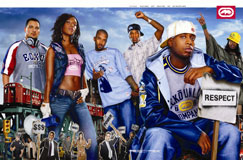Scion is making effective use of the Internet by using live chat to attract the 18-24 year old audience. Also part of the campaign are microapplication ads that allows consumers to stencil designs over pictures of the Scion.
"Chat is a popular medium for the 18-to-24-year-old demographic, so we decided to try it out," said Scion Sales Manager Brian Bolain. "This generation grew up with computers. They use AOL Instant Messenger and cell phones. We decided it was time we responded to them in the way they are accustomed to."
The on-site chat is powered by LivePerson and Scion says it is getting hundreds of conversations a week. Prior to the chat, users are asked a few question, one of which is where they live. Interestingly, Scion found that many of the chatters reside in areas where Scion is not even available providing valuable information for dealer expansion plans.
Ads are so much more fun in Europe. This ad for Leo's Sports Club puts all other butt-building health related ads to shame. The question remians, though, whether you'd really want to eat that nut once it's been given the Leo's Sports Club butt-nut-crackin' treatment. Via TTR2.
Study after study show newspaper readership heading downward and the use of the Internet to find news rising rapidly.
"Each succeeding generation of under-30s seems less oriented toward newspapers. That's why pessimists foretell the long-term doom of newspapers, but we're not so quick to say that," said Pew Research Center Editor Carroll Doherty. "Newspapers are still a major source of news for many millions of Americans. So even if the trends are cloudy, newspapers have an enormous base of readers at a time when media fragmentation is considerable."
While the Internet rises as a means to retrieve news, it's still the old-school newspaper reporter walking the beat in search of the news that fills both the pages of the printed newspaper and the "pages" of news website.
"Printed newspapers are not going away in our lifetime," said David Card of New York-based Jupiter Research. "But I doubt that a lot of young people who grew up on TV and the Internet are going to retreat to the printed newspaper as they settle into middle age."
With the rise in Internet usage and the increasing prevalence of wireless access to news sources, my feeling is the printed newspaper is going to die quicker than many think.
Bravo is going full-on gay. After the success of "Queer Eye for the Straight Guy," the cable net is casting for a show that has gay guys giving single girls makeovers and then hooking them up with straight guys. The show, copied in the usual "TV has no original ideas" tradition, is mirrored after the U.K. show, "Straight Dates by Gay Mates." Gawker has commentary and you can apply here.
In her MediaPost Out to Launch column this week, Amy Coor features a new print campaign by Ecko Unlimited called Dreamnasium II. The campaign for the clothier features Hugh Hefner, Fat Joe, DJ Mix Master Mike of the Beastie Boys, Talib Kweli, Dead Prez, and VJ Julissa.
Other new ad campaigns launched and covered in Amy's column include the PGA, AARP, the AFL, MoveOn, the National PTA and Jose Quervo.
An InsightExpress survey of consumers and media buyers reports both groups think the cost of Super Bowl ads is not worth it. However, 83 percent of media buyers say publicity achieved surrounding the game is the number one reason for paying the high price.
TV Guide's Jeff Gemmill is concerned about where MTV is headed:
Still, there's a more immediate concern. When considering Newlyweds, Do Us Part, The Osbournes and upcoming reality shows centered on Hilary Duff and 7th Heaven star Ashlee Simpson (Jessica's little sister), MTV's slow metamorphosis into a Lifestyles of the Rich and Famous channel for Generations Y and Z is just about complete. (For further evidence, see Cribs.) In essence, what was arguably once the Rolling Stone of the airwaves is in danger of becoming the US Weekly of TV.
Three stories today paint a stark picture of the changing media landscape. First, Business Week points out that networks are losing viewers and are reacting by breaking with the typical no-new-shows-during-the-Summer approach. Second, the Wall Street Journal and MediaPost have stories addressing the fall in magazine ad pages and suggesting publishers better kick butt to get back on track. And third, the ever well spoken Jim Meskauskus writes in iMediaConnection that beverages could see big returns with online advertising.
As an example of why certain copy points are usually left out of some ads, here's one classified car ad that would probobly sell better if the copy were just a bit less honest:
Brand new Blue paint(2003)w/Blue Leather. Power everything, Sunroof, A/C ice cold. Interior and exterior in great condition. Engine runs perfectly and recently serviced. Air suspension perfect! Car was used in adult film 'Highway Gangbang - In Da Butt'. May require some light interior cleaning. Car must be moved ASAP.
Via Apechild.
An Adrants reader asked me if I had seen the new MSN online ad campaign which shows people of different demographic types and how the new MSN can serve each of those individual's needs. The ads ask you to click through and find out more about the person and the service. In particular, the reader asked me if I had seen the "Meet Amanda" version of the ad campaign. I said no but after looking at it, I realize I had. She's definitely all-American cute. The reader, who wishes to remain anonymous wrote:
"It seems like MSN's trying to turn banner ads into boner ads. The downside: clicking the ad doesn't let you get to know Amanda any more intimately. (And let's not get into the fact that she's probably all of 15. Girls wearing pants that low are asking for it.) "
Why yes, and with her brace-face, she certainly isn't more than 15 or 16 which, of course, is the point. The point being to get to know her and MSN better, not bone her. But I can see alternative viewpoints on that one. While this may be a "boner ad," it, like the other versions, are presenting varied demographic backgrounds to appeal to the widest possible audience. Though, with a median age of 39.9, MSN might want to consider giving this ad heavier rotation to bring in younger users. On second though, perhaps not. After having converted Chat from free to pay, what's a 15 year old to do on MSN anymore?

|





